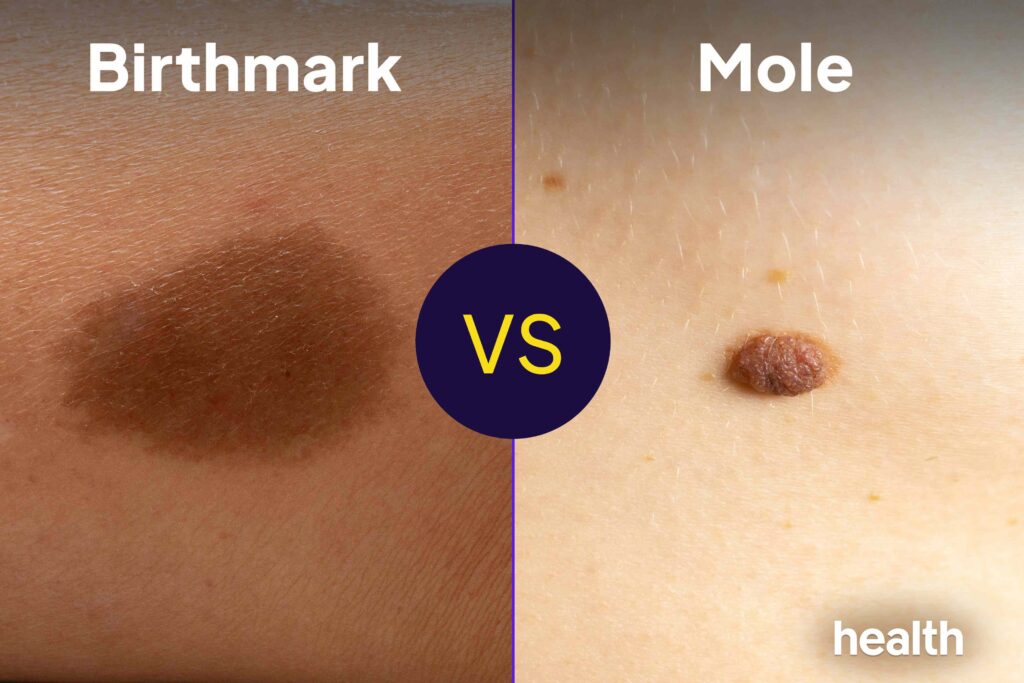Birthmarks and moles are types of skin markings that are mostly harmless. But because moles may rarely turn into skin cancer (melanoma), it’s important to be able to tell these skin issues apart.
A birthmark is a skin discoloration, marking, or growth that’s present at birth or develops shortly after. Its shape, color, size, and location can vary a great deal, and there are many different types.
While they can form anywhere, you’re more likely to find certain types of birthmarks on certain parts of your body. Some are permanent; others eventually fade.
There are two categories of birthmarks:
- Vascular birthmarks: These are the most common. They’re caused by abnormal blood vessels and look reddish, typically.
- Pigmented birthmarks: These are caused by clusters of pigment skin cells, leading to tan, brown, or black, gray, or blue patches.
Types of Birthmarks
Common types of vascular or pigmented birthmarks include:
- Strawberry hemangioma: These strawberry-colored birthmarks may grow until infants are 4-6 months old. About 90% of these fade by age 10.
- Deep hemangioma: With a blue or purple color, this type feels like a deep lump and may be painful.
- Salmon patch: These pinkish or red-colored patches typically grow on the face or back of the neck.
- Café-au-lait spots: These birthmarks have well-defined borders and are brown on lighter skin or darker brown to black on darker skin.
- Port-wine stain: This birthmark usually affects the face. With a distinctive red or purple color, this type can thicken and form rough, cobblestone edges. It doesn’t go away and grows with age.
- Mongolian spots: Usually affecting the buttocks or lower back, these look like bruises and are light or dark blue or grey. They usually fade when children are 3-5 years old.
- Nevus sebaceous: This type typically grows on the scalp, leaving a bald and raised patch. Over time, it can change, turning yellow or orange and becoming “pebbly” or bumpy. This type doesn’t go away.
- Moles: Moles can also be birthmarks. These “congenital melanocytic nevi” range from small spots to larger patches of skin and are usually permanent.
Moles are small spots caused by an overgrowth of melanocytes, or cells that give skin its color. They’re very common—most adults have 10-40 moles. People develop moles in late childhood, adolescence, or young adulthood.
Varying in size and shape, moles usually grow on sun-exposed skin above the waist. There are several types:
- Common mole: Flat or slightly raised and rounded, these have one color. Moles can sprout hair, and some fade over time.
- Atypical mole: Atypical moles, or dysplastic nevi, resemble skin cancer. Larger and more irregularly shaped than common moles, this type is multi-colored and can be brown, red, green, or purple.
- Spitz nevus: Another that looks like skin cancer, a spitz nevus is typically raised, round, and pink with other colors like red, black, or brown. Usually setting on by age 20, this type may bleed or ooze fluid.
Birthmarks and moles differ in how they look, when they develop, their causes, and what they mean for your health.
- Shape and color: Common moles are more regularly shaped, symmetrical, and may appear in groups. They’re usually brown, black, or darker than skin around it. Birthmarks may be less evenly shaped, they don’t form in clusters, and some may be redder or pinker.
- When they appear: A birthmark is present when you’re born or forms soon after. Some people are also born with moles, but moles can also develop up until you’re about 40 years old.
- Genetic influence: Mutations in certain genes may make you more likely to develop moles. The genetic link is less clear with birthmarks. While some studies found genetics to influence certain types, researchers don’t know how much.
- Risk factors: Sun exposure is a common risk factor for moles. Risk factors for birthmarks may include premature birth, low birth weight, and other birth-related factors, such as being a twin or triplet.
- What they mean for your health: Rarely, moles can develop into a type of skin cancer called melanoma. Birthmarks are rarely cancerous, although being born with a mole (congenital melanocytic nevus) may raise the risk. Sometimes, some types of birthmarks may cause pain or difficulties with self-esteem.
A dermatologist is a skin specialist. They can be helpful if you have a birthmark or moles.
For a Birthmark
You can see a dermatologist if a birthmark bothers you. There are options, like surgery and medication, that can help reduce a birthmark’s size or appearance.
It’s also important to talk to a dermatologist if your birthmark:
- Bleeds
- Itches
- Hurts
- Becomes infected
For Moles
It’s a good idea to have regular visits with a dermatologist if you have moles and other risk factors for skin cancer. The risk of a mole becoming cancerous is highest if you have:
- A family history of skin cancer
- Many small or several large moles
- Many atypical moles
- Light skin that burns easily or forms freckles
- Weakened immune system due to disease or medical treatment
To help recognize signs that suggest you need medical care from a dermatologist, remember the ABCDEs of melanoma:
- Asymmetry (A): One side of a mole is not the same as the other
- Border (B): The mole has edges that are hard to see, irregular, or ridged
- Color (C): Your mole changes color or has different colors in different parts of the growth
- Diameter (D): Growth is larger than 6 millimeters, or about the width of a pen
- Evolving (E): Your mole changes in shape and color or size over time
Birthmarks are skin markings you’re born with, while moles usually develop in childhood, adolescence, or young adulthood. While almost all birthmarks are harmless, moles can sometimes turn into skin cancer. Have your healthcare provider check out any growth on your body that’s uneven or changes shape or color.


